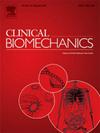Anterior variable-angle locked plating of complex patella fractures – Does the type of polar screw matter?
IF 1.4
3区 医学
Q4 ENGINEERING, BIOMEDICAL
引用次数: 0
Abstract
Background
Treatment of complex patella fractures represents a challenging clinical problem. Whereas controversy exists regarding the most appropriate fixation method, anterior plating is an emerging treatment option. A novel design of anterior variable-angle locking plates features radiating legs with integrated screw holes aiming at capturing fragments of the distal comminuted zone via either a locking or a cortical polar screw.
The aim of this study was to compare the biomechanical performance of the novel anterior variable-angle locking plates used for fixation of complex patella fractures with either a locking or a cortical polar screw.
Methods
Complex five-part AO/OTA 34-C3 patella fractures mimicking comminution around the distal pole were simulated in twelve human cadaveric knees. Specimens were randomized to two groups for treatment with an anterior variable-angle locking plate fixing the patella with either one locking or one cortical caudo-cranial bicortical polar screw. Biomechanical testing was performed over 5000 cycles by pulling on the quadriceps tendon, simulating active knee extension and passive flexion within the range from 90° flexion to full extension. Interfragmentary movements were captured by motion tracking.
Findings
No significant differences between the two fixation techniques were detected in terms of longitudinal and shear articular displacements, and relative rotations around the mediolateral axis measured between the proximal and distal fragments at the central patella aspect between 1000 and 5000 cycles, P ≥ 0.116.
Interpretation
From a biomechanical perspective, anterior locked plating of complex patella fractures provides comparable fixation stability when using either a locking or a cortical polar screw.
复杂髌骨骨折的前路变角度锁定钢板-极螺钉的类型重要吗?
背景:复杂髌骨骨折的治疗是一个具有挑战性的临床问题。尽管关于最合适的固定方法存在争议,但前路钢板是一种新兴的治疗选择。一种新型的前路可变角度锁定钢板设计,其特点是具有放射状腿和集成螺钉孔,旨在通过锁定或皮质极螺钉捕获远端粉碎区碎片。本研究的目的是比较新型前路可变角度锁定钢板与锁定螺钉或皮质极螺钉固定复杂髌骨骨折的生物力学性能。方法采用12例人体尸体膝关节模拟复杂的AO/OTA 34-C3髌骨远端骨折模拟粉碎。将标本随机分为两组,采用前路可变角度锁定钢板固定髌骨,同时使用一枚锁定螺钉或一枚皮质尾颅双皮质极螺钉。通过牵拉股四头肌肌腱进行了超过5000次的生物力学测试,模拟从90°屈曲到完全伸直范围内的主动膝关节伸展和被动膝关节屈曲。通过运动跟踪捕捉碎片间的运动。在纵向和剪切关节位移方面,两种固定技术之间无显著差异,髌骨中央近端和远端碎片在1000和5000圈之间测量的围绕中外侧轴的相对旋转,P≥0.116。从生物力学的角度来看,无论是使用锁定螺钉还是皮质极螺钉,前锁钉钢板治疗复杂髌骨骨折都具有相当的稳定性。
本文章由计算机程序翻译,如有差异,请以英文原文为准。
求助全文
约1分钟内获得全文
求助全文
来源期刊

Clinical Biomechanics
医学-工程:生物医学
CiteScore
3.30
自引率
5.60%
发文量
189
审稿时长
12.3 weeks
期刊介绍:
Clinical Biomechanics is an international multidisciplinary journal of biomechanics with a focus on medical and clinical applications of new knowledge in the field.
The science of biomechanics helps explain the causes of cell, tissue, organ and body system disorders, and supports clinicians in the diagnosis, prognosis and evaluation of treatment methods and technologies. Clinical Biomechanics aims to strengthen the links between laboratory and clinic by publishing cutting-edge biomechanics research which helps to explain the causes of injury and disease, and which provides evidence contributing to improved clinical management.
A rigorous peer review system is employed and every attempt is made to process and publish top-quality papers promptly.
Clinical Biomechanics explores all facets of body system, organ, tissue and cell biomechanics, with an emphasis on medical and clinical applications of the basic science aspects. The role of basic science is therefore recognized in a medical or clinical context. The readership of the journal closely reflects its multi-disciplinary contents, being a balance of scientists, engineers and clinicians.
The contents are in the form of research papers, brief reports, review papers and correspondence, whilst special interest issues and supplements are published from time to time.
Disciplines covered include biomechanics and mechanobiology at all scales, bioengineering and use of tissue engineering and biomaterials for clinical applications, biophysics, as well as biomechanical aspects of medical robotics, ergonomics, physical and occupational therapeutics and rehabilitation.
 求助内容:
求助内容: 应助结果提醒方式:
应助结果提醒方式:


